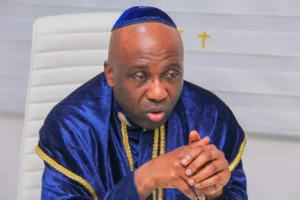Ten Christmas Traditions and Their Origins

Christmas is celebrated to mark the birth of Jesus Christ. Understanding the traditions associated with Christmas is important because, by knowing the origins and meanings behind these traditions, we can appreciate their depth and significance. This article explores the fascinating stories behind popular Christmas traditions.
Here are some of the popular Christmas traditions:
1. Red and green
When we think of Christmas, we often think of red and green decorations or red and green clothing. According to research, the association of the colours red and green with Christmas is traced back to a certain plant: holly. Holly plants are known for their bright green leaves and red berries.
Tragic Occurrence: Nigerian Man Dies Three Days To His Wedding
Today, Christians have adopted the holly tree as a symbol for Christmas. The sharp leaves are said to symbolise the crown of thorns worn by Christ, while the berries represent his blood. Holly is a winter-blooming plant and may be one of the few signs of green during the season. Over time, the combination of red and green has become deeply ingrained in Christmas traditions, decorations, and imagery, representing the warmth and joy of the holiday.
2. Santa Claus

A main inspiration for Santa Claus is Saint Nicholas, a third-century Christian who was known for his kindness and charity. He also enjoyed giving kids gifts in secret. He later became a local folk hero, and stories about him expanded into elaborate myths and legends over the centuries. Over time, different customs and stories merged to create the modern image of Santa Claus that we know today.
With each new story, different cultures and peoples would add their unique twists and embellishments to the story of St. Nicholas.
As time went on, these characters barely resembled the original St. Nicholas and became totally new figures separate from him.
Today, many countries in the world tell stories of many different versions of a St. Nicholas-inspired character that gives gifts to children during Christmas.
3. Santa’s elves
According to legends, elves were small dwarf-like creatures with pointy ears who protected good people from evil. They stay at the North Pole with the legendary Christmas figure, Santa Claus, to help him in his workshop. These young magical creatures came in both genders and wore pointy hats and red and green clothes. They had long noses and sharp ears.
These elves worked in Santa’s workshop, assisting him in the creation of toys for good children all over the world. Apart from helping Santa in his workshop, the elves were also in charge of caring for Santa’s reindeer and carriage.
4. Santa’s reindeer
Since the release of Clement Clark Moore’s poem ‘A Visit from St. Nicholas’ in 1823, reindeer have been known as Santa’s sleigh pullers. From their habitat in the cold, icy Arctic, reindeer have evolved unique features that help them thrive in these harsh environments and make them the perfect Santa’s helpers. Their hooves have the ability to grow and shrink, depending on the season. Santa Claus’ reindeer are said to pull a sleigh through the night sky to help Santa Claus deliver gifts to children on Christmas Eve.

5. Christmas stockings
This tradition can be traced back to the original Saint Nicholas, who was said to have put gold coins in the stockings of three poor sisters. One night, the girls left their stockings drying over the fireplace. Saint Nicholas knew the family was very poor, so he threw three bags of gold coins down the chimney. The money landed in the sisters’ stockings. Since then, children have been taught to hang up their Christmas stockings on Christmas Eve, hoping to find them filled with gifts in the morning. This comes with the anticipation and excitement of receiving presents.
6 . Christmas trees
The Christmas tree is a cherished tradition. People bring a beautiful evergreen tree into their homes and decorate it with lights, ornaments, and garlands. Families often gather around the tree to exchange gifts. Decorating buildings with trees during the winter is a practice that can be traced back to ancient peoples like the Romans and Egyptians, who often used trees to add to the beauty of shrines or temples.
However, the modern Christmas tree is said to come from German medieval traditions. Germans would decorate a tree in their homes on December 24 in order to celebrate the feast day of Adam and Eve. As time went on, these trees would also be used to celebrate the birth of Jesus Christ during Christmas. Whether real or fake, a beautifully decorated Christmas tree can often be found inside a heavily decorated home, just waiting for St. Nick to put wonderful presents (or a pair of socks) underneath it.
RELATED NEWS
YULETIDE: NIGERIAN GOVERNOR DECLARES SEVEN DAYS PUBLIC HOLIDAY FOR STATE CIVIL SERVANTS
Jubilation As Governor Approve N100,000 As Christmas Bonus For Each Civil Servant in
Yuletide: 30 Merry Christmas Messages And Wishes To Send To Friends And Family
Yuletide: Why We Must Avoid Food Waste This Christmas
7. Presents
St. Nicholas was known to give gifts to children, which is why his ‘descendant’, Santa Claus, does so as well. Gift-giving also has its roots in pagan rituals held during the winter. When Christianity folded these rituals into Christmas, the justification for bearing gifts was redirected to the Three Wise Men, the Magi, who gave gifts to the infant Jesus. As for modern Christmas gift-giving, this tradition seems to have been strengthened and encouraged thanks to the popularity of Santa Claus and the commercialization of Christmas.
8. Christmas Carol
Carols have their roots in pagan rituals appropriated by the nascent Christian Church when, in the 4th century, it officially named Christmas the celebration of Christ Jesus’ birth. Carols were first sung in Europe thousands of years ago, but these were not Christmas carols. They were pre-Christian or pagan songs sung at the Winter Solstice celebrations. The Winter Solstice is the shortest day of the year, usually taking place around December 22. Christmas, remembering the birth of Jesus, then started to be celebrated at the same time as the solstice, so the early Christians started singing Christian songs instead of pre-Christian or pagan ones.
9. Christmas Bell
You cannot talk about the sounds of Christmas without mentioning Christmas bells. Bells have always been rung for a variety of reasons. The ringing of bells has been an important part of celebrating Christmas since ancient times. Bells have been used in the past to not only provide music and a sense of celebration, but they have also been rung to announce the arrival of the Christmas season. They can symbolize the announcement of the birth of Christ. Bells were also part of the Jewish high priest’s garments. Christmas bells not only symbolize the joy of Christmas; they also remind us that Christ is the High Priest.
Christmas bells can be seen on light posts that light up the streets at night, are hung on many Christmas trees, and can be heard in every house in America that celebrates Christmas.
10. Boxing Day
Boxing Day is a holiday celebrated after Christmas Day, occurring on December 26. Boxing Day got its name when Queen Victoria was on the throne. In Victorian times, the wealthy would box up items they no longer needed to give to the poor. It was a day where servants would be given time off and thanked for their hard work with a ‘special box’ of treats.
Fact-Check: The Story Of Nigeria’s Most Notorious Armed Robber In The 1980’s, Anini
Other reports say that many people believe that the tradition of Boxing Day began in churches in the Middle Ages, where parishioners would collect money for the poor. This was done to honour St. Stephen, the first Christian martyr, whose feast day fell on December 26
[PUNCH]









